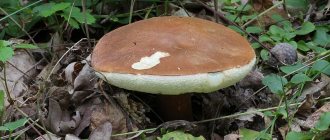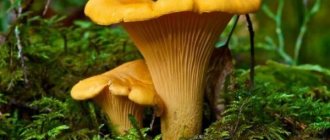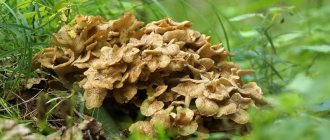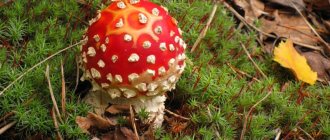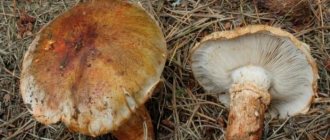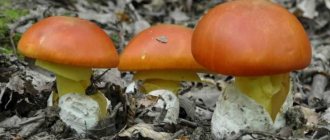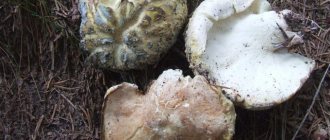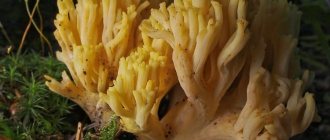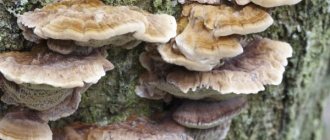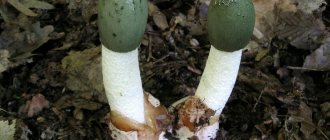Avid mushroom pickers are well acquainted with tinder fungus, so they know its beneficial properties and often use this mushroom in traditional methods of treatment. But due to the fact that there are many species and poisonous counterparts, it should be treated with caution so as not to be confused and poisoned. What are the features of this family, how to distinguish edible ones and what ailments can they help with?
Polypore is a general name for a family of parasitic fungi that grow on the trunks of living and rotten trees, where they decompose organic compounds into mineral analogues. And although they indicate a destructive effect on plant wood, for humans mushrooms can have a healing effect when used correctly. In medicine, reishi, sulfur-yellow, larch and birch species are often used: due to essential oils, resins, vitamins and macroelements, the main ingredient has a positive effect on the body's microflora.
From Latin - Polyporaceae.
Features of the tinder fungus
The tinder fungus consists of mycelium and fruiting body, which are formed by thin transparent threads. A significant part is located directly in the body of the fungus, and only the reproductive organs (spores) are located outside. Although the hyphae of the parasite appear on the wood not by force, but through the secretion of enzymes that gradually dissolve the cell membranes of the surface of the trunk. Later, cracks appear in the tree bark, where the spores settle, and after the mycelium has spread, the remaining fragments of the tinder fruiting body appear.
Description and photo
Visually, the tinder fungus resembles the bottom of an inverted saucer, which has partially grown into the trunk. The size of the caps ranges from 10 to 40 cm, with the maximum thickness observed in the zone of contact with the tree trunk - about 7 cm. And the mass of a whole mushroom can vary between 8-10 kg. The edge of the body appears slightly wavy and is divided into lobes by deepened cracks. There is light fluff along the entire cap. The surface itself is smooth, covered with a thick crust of white, smoky, brown or brownish-yellow shades. The older the mushroom, the darker the crust becomes, reaching almost black color.
Reference! In humid weather, drops of liquid are released on the mushroom, and a barely noticeable reddish tint appears.
The structure of the tinder pulp directly depends on the typology of the fungus. It is usually tough, woody with a yellow-brown color and a faint fruity aroma. The pores of the fungus are represented by rounded tubes, which are arranged in layers: every year a new layer 5 mm thick grows on top. Fresh pores have a light gray color, but over time they become yellow-gray, and when pressed they turn brown.
general characteristics
This mushroom is long-lived and is found in places where there are many trees. For them, this is a real mortal enemy. As it grows, it causes the formation of white rot. If a tree is infected with such a fungus, it will die quite quickly. This happens because a false tinder fungus has appeared on the tree, the age of which, by the way, is not at all difficult to determine. Every year a new layer appears at the bottom of the mushroom. It is almost impossible to separate them, but they are easy to count.
Unlike the real tinder fungus, the surface of the false type is riddled with cracks. They are quite deep in nature. This species belongs to the polyporous fungi. Most of them are inedible. Such a representative is included in the genus Phellinus, which has several species, for example, the pine sponge, which includes the false pine polypores.
False tinder fungi have many other names. They are also called burnt mushrooms, and are popularly called tree mushrooms. If you literally translate the name from Latin, you get “cork.” The variety of false polypores fits into one genus, Phellinus. This name was not given to these mushrooms by chance. Indeed, in adulthood it somewhat resembles a cork, the location of which is the bark of a tree.
Where do tinder fungi grow?
The tinder fungus is considered a perennial mushroom, so it can be found in nature all year round. Their pores most often cluster on dead wood and stumps, and are much less likely to parasitize already weak trees. But this fungus can also develop on dead wood for several years after the death of the plant, causing brown rot. Typically, tinder fungi prefer deciduous trees:
- beech;
- alder;
- birch;
- cherry;
- willow;
- oak;
- Linden;
- white acacia;
- poplar;
- larch;
- pear.
Less commonly, this family of fungi can be found on spruce, yew and eucalyptus. Parasites are located at the bottom of infected trunks at a height of 3 to 20 meters. It often grows in forests and parks, and forms on trees that grow within the city, near roads. Fruits from May to mid-September. Distributed throughout Russia, in addition to the Far North.
For medicinal purposes, tinder fungus is specially grown in Asian countries, and in Europe and the USA.
Thuja diseases
Young shoots and leaves are affected, turning yellow or acquiring a reddish-brown color. On rounded dying areas of the bark and leaves, sporulation of the pathogen is formed, which has the form of crowded black-brown rounded tubercles with a diameter of up to 0.3 mm, protruding from breaks in the integumentary tissue.
Pestalotiopsis necrosis (caused by the fungus Pestalotiopsis funerea)
Pestalocyopsis necrosis
Young shoots and leaves are affected, becoming light brown or red-brown in color. Leaf damage begins from the top of the shoots, spreading downwards. On dying and dead leaves and bark, sporulation of the fungus forms in the form of a few scattered black rounded tubercles up to 0.2 mm in diameter, protruding from cracks in the integumentary tissue. Mature spores emerge on the surface of the affected leaves and shoots in the form of dark brown, almost black drops and thin strands, which serve as a characteristic sign of the disease.
Phomopsis necrosis (caused by the fungus Phomopsis juniperovora)
Affected shoots and leaves turn brown. On the dead bark and in the axils of the leaves, sporulation of the pathogen forms in the form of black round tubercles. Mature spores emerge on the surface of the affected organs in the form of light drops or strands.
Cytospor necrosis, or osteoporosis (pathogens are fungi of the genus Cytospora)
Mostly trunks and branches are affected, less often leaves, which become brown in color. The disease is detected by the sporulation of pathogens that look like numerous, very small conical tubercles with dark apices. Mature spores emerge on the surface in the form of clearly visible golden-yellow, orange or reddish drops, thin flagella and spirals. (Read more about the disease in one of our articles).
Diplodia necrosis, or diplodiasis (caused by the fungus Diplodia thujae)
The bark of trunks, branches and leaves is affected. The color of the bark remains almost unchanged, and the leaves become brown or red-brown. On dead areas, sporulation of the pathogen is formed, which takes the form of numerous scattered black rounded tubercles with a diameter of up to 0.5 mm.
Brown Schutte (caused by the fungus Herpotrichia juniperi)
The pathogen develops under snow in winter, so only the leaves of that part of the crown that is in the snow cover zone in winter are affected. After the snow melts, the infected leaves are covered with thick dark brown mycelium (mycelium), which seems to glue the affected shoots together. On the mycelium, the fruiting bodies of the fungus are formed in the form of black spherical small tubercles, poorly visible on the brown mycelium. Over time, the mycelium is destroyed, and dirty brown fragments remain on the affected leaves.
Adult thuja trees can become infected with wood-destroying fungi, of which the most dangerous are the causative agents of root rot: honey fungus (Armillaria mellea), root sponge (Heterobasidion annosum), flat polypore (Ganoderma lipsiense), and Schweinitz polypore (Phaeolus schweinitzii).
Honey fungus on the trunk Fruiting bodies of the root sponge Fruiting body of the tinder fungus Shveinitz
All these diseases arise, as a rule, against the background of a preliminary weakening of the thuja, caused by various unfavorable factors (weather conditions, imbalance of nutrients in the soil, pest damage, etc.).
Collection and preparation
Mushroom picking time is from August to November. The right decision would be to search for tinder fungi at a young age, but in older ones it is better to use only the cap. They are eaten fresh: they are rarely salted and dried. It is more convenient to knock down large fruiting bodies (always white inside) with sticks or axes. But they should be cut exclusively from living trees, and not rotten trunks. Among the tinder fungus, there are 2 commercial varieties of the fungus - cleared of bark residues and cleared, in addition, of its own outer crust. The pulp must be cut into pieces before further processing. Infusions are prepared using boiled water or vodka and are always infused. Mushrooms should be stored in the refrigerator.
Description
The surface of the mushroom is covered with a black crust. The mushroom is attached to the tree sideways. The body is round with blunt ends. The shape looks like a hemisphere or hoof. The diameter of the mushroom can reach up to 25 millimeters, and its height is 12 cm.
It is very difficult to distinguish different types of mushrooms by external signs, but this can be done by the type of tree on which it grows. Some of them prefer poplar, others prefer pine, and other types of trees. The false tinder fungus is a perennial fungus, but it cannot be classified as a tubular species, since the location of the tubes is the inside of the fruit itself. One new layer is formed every year. It is represented by a hard hoof-like growth. It is characterized by significant color variability with different shades. The color can be chestnut or even cherry shades.
The mushroom is very tough, so it is not eaten. Its hardness cannot be eliminated even if it is boiled for a long time. But one should not assume that this representative is useless for people. It is quite widely used for medical purposes.
Main types of tinder fungi
Now there are more than 1,500 species of tinder fungi, most of which are classified as conditionally edible mushrooms.
Beveled
A beveled mushroom (or chaga) has the shape of an asymmetrical growth on a tree trunk measuring 5-20 cm. In appearance, it is a semicircular lumpy mass of black-brown color, rough to the touch and dotted with deep cracks. Its flesh is also hard, has a brown tint and light veins. There is no specific smell.
This tinder fungus stops growing as soon as the trunk completely rots. Then the fungus also begins small transformations: on the opposite side of the attachment, a lobed formation appears, about 39-40 cm wide and maximum 3 m long. The bottom of the new growth is covered with tubes, the edges turn up and change their color towards a natural woody shade. When the tree bark is completely destroyed and the fungal spores ripen, the tinder fungus will darken and dry out.
Look at the article on the topic - Chaga mushroom (birch).
Birch
The tinder fungus, which grows on birch trees, is a type of annual parasitic fungus. It usually affects old, weak and dry trees with thin trunks, but sometimes it can spore in a healthy tree. The fruiting body of the mushroom is devoid of legs and is a hemisphere with a diameter no wider than 20 cm and a height of up to 6 cm. The young mushroom has a characteristic light gray tint, and over time it gradually darkens, complemented by brown tones. The lower part of the tinder fungus resembles a sponge. The pulp is white and dense, with an unobtrusive odor. Towards the end of ripening, the middle of the mushroom becomes harder. It has a huge distribution area because it prefers to grow on one of the most typical trees for Russia - birch, preferring damp, protected from light areas (in shaded forests, near swamps and other bodies of water).
Red
The name speaks for itself. It is impossible not to confuse him. It has red flesh that hardens over time. Look at the photo to get a better idea.
Winter
The cap of this tinder fungus is small, with a diameter of no more than 2-5 cm, but sometimes they reach 10 cm. The edges are most often curved. The shape is flat-convex; at times there may be depressions (especially in large specimens). The color of the mushroom has several variations: gray-brown, yellow-brown or brown. The yellowish-white flesh is elastic, but the leg, on the contrary, seems very dense, becoming even tougher and leatherier over time. The lower half is represented by a hymenophore, consisting of cream-colored tubes. The color of the spore powder is white.
Winter tinder fungus is considered a species that is not recommended to eat, but the caps of young mushrooms are often dried or set aside freshly prepared for infusions. According to nutritional value, these mushrooms occupy the last position (IV category), since they are completely devoid of expressive taste and are hard.
Scaly
The fruiting body of this mushroom is large, 10-40 cm in diameter with a kidney-shaped thick cap. The surface of the tinder fungus is leathery, yellow in color, with sparse dark brown scales, which are arranged symmetrically in circles. Thin fan-shaped edges correspond to the type of tile. The flesh is dense but juicy and has a very pleasant smell, although older specimens seem harder to the touch. The lower lobe of the cap has a tubular shape with rather large angular pores.
The scaly tinder fungus has a thick lateral leg, sometimes not coming from the center of the cap. It reaches up to 4 cm in width and up to 10 cm in length. The top layer is dotted with brown scales. But the lower part is lighter with a spectacular mesh pattern. Most often, mushrooms grow singly or in entire clusters not only in broad-leaved forests, but also in parks, forming small clusters in the shape of a fan.
Varnished
Polypores of this type are found in almost all corners of the world. These are saprophytes - wood destroyers, after whose exposure white rot appears on the trunk. They settle primarily on weakened or damaged deciduous trees, less often on coniferous poles. Sometimes varnished mushrooms can be found even in ordinary soil from July to late autumn.
The diameter of its cap is on average 8-20 cm, has an ovoid shape and in structure is as close as possible to the woody type. It is covered on top with a shiny, smooth skin, divided into numerous multi-colored circles. The color of the mushroom itself varies from scarlet to violet-brown, sometimes reaching black. The height of the leg varies from 5 to 25 cm: it is oblong, dense and uneven, cylindrical in shape and grows from the side. The flesh of the tinder fungus is very hard, ocher-colored, and has no taste or smell. The pores are round and miniature, white or yellow in color, but the spore powder has a brown tone.
Ramified
The fruiting body of the tinder fungus looks very unusual: it consists of multi-layered branched legs with tiny light caps (about 10-200 pieces, up to 4 cm in diameter each). All branches converge at the base into a tuberous stalk. The young mushroom is round in shape, although over time it becomes flatter, with a characteristic small depression in the middle. The color of the caps ranges from light brown to grayish-brown. The pulp is white, fleshy, with the smell of dill. But the spore powder is white.
Regarding locations, the mushroom itself is not picky: it grows in mixed forests at the roots of trunks and stumps of deciduous trees, mainly oak, maple and linden. It is most often found in July - August, but it can be collected until November inclusive.
Umbrella
This tinder fungus has an unusual bush-like shape. The base of the body is represented by an impressive number of wavy caps and legs intertwined with each other. In the middle there is a small depression covered with small scales. More than 200 fruiting bodies can be present on a single clump. The aroma of the pulp of the umbrella mushroom is attractive, associated with the smell of fresh dill. The color of the pulp is white. At the bottom of the cap area there is a tubular hymenophore, which smoothly descends along the stalk. They are small and short in shape (1-1.5 mm in size). The spores are cylindrical in shape and cream or white in color. Their structure is quite thin and soft, connected at the base.
This type of tinder fungus is easy to find in the European part of the country, in Siberia and the Polar Urals, and often grows in the regions of Western Europe and North America. Umbrella mushrooms usually cluster at the base of trunks, preferring oak, linden and maple. Although they often grow on stumps, dead wood and litter of fallen leaves that begins to rot.
Sheep
The cap of the described tinder fungus has a characteristic round shape, reaching a diameter of 9 cm. Many cracks appear in old mushrooms. The skin on the surface is silky and dry to the touch, but over time it becomes slightly scaly, especially in dry weather. The edges of the cap are pointed, thin and therefore slightly wavy and drooping. The lower part is covered with a dense layer of tubes, which are easily separated from the pulp. Color variations range from snow-white to greenish-yellow. The spores are ovoid or almost perfectly round, smooth, often with large fatty droplets inside. The size of the leg does not go beyond 3-7 cm. The pulp is cheese-like, dense, but at the same time brittle. The smell is unpleasant, soapy, although sometimes it is faintly noticeable, even pleasant with notes of almonds or flour products
The sheep species is not encountered by mushroom pickers too often. They actively bear fruit from July to October, found on soils in coniferous and mixed forests (on small edges, along highways, in clearings, paths and in the mountains). Such tinder fungi easily get along in alkaline and neutral soils and moss. Sometimes they form groups, closely adjacent to each other, so much so that the edges of their caps and legs can grow together. They are rarely found as individual specimens. Mushrooms are widespread in the northern temperate zone: North America, Europe, Asia and Australia. In Russia, they grow in the Far East and Siberia.
Natural prevalence
It is quite widespread in European countries and in our country. Its habitat is deciduous and coniferous forests. Most often it can be seen on the trunk of a birch tree. It can appear not only on a sick, rotting tree. It is likely that it will appear on healthy trees. In addition, it prefers to grow on stumps and dead wood. Most often it is characterized by single growth, but pairs can often be found. Fruit formation is observed in the warmest season. This begins in May and ends in December.
Medicinal and beneficial properties of tinder fungus
A significant amount of bioactive substances have been found in the tinder family. The leading place among them is occupied by the following elements:
- amino acids;
- glycosides;
- steroids;
- lecithin LSL;
- polysaccharides;
- phenols;
- phytoncides;
- pigments;
- cellulose;
- mineral compounds (manganese, magnesium, potassium, iron, sodium, zinc, aluminum, cobalt, copper, nickel, silicon, silver);
- organic acids (acetic, oxalic, formic, butyric and others).
The watery extract of fresh fruiting bodies is characterized by pronounced antimicrobial and antiviral effects. The mycelium extract suppresses the malarial plasmodium and is considered methicillin-resistant Staphylococcus aureus, and in addition is toxic to Escherichia coli, one of the main causative agents of inflammation of the urinary canals in fibrosis. And recent experiments have confirmed the fact that the elements that make up this mushroom reduce the risk of contracting the HIV virus.
Among other medical properties, we can highlight the reduction of blood sugar levels and noticeable benefits for endocrine diseases due to the content of eburicoic acid. Some sources claim that this mushroom is used as a mildly poisonous and even hallucinogenic mushroom, since it has a laxative effect.
Excessive consumption of polypore may cause swollen lips, nausea, vomiting and dizziness.
Regarding the medicinal properties of the mushroom, the risk of allergic reactions when eating it cannot be ruled out. Typically, such information refers to specimens collected from coniferous trees, so in order to exclude cases of poisoning and negative consequences, you should look only for those tinder fungi that grow on deciduous trees.
Remove toxins
Residents of Ancient Rome and Greece believed in the healing effect of this mushroom family. In those days, real tinder was worth a lot of money, so it was almost impossible for ordinary people to purchase it. But among the nobility this mushroom became widespread primarily thanks to the famous recipe of King Mithridates. This ruler made a grand discovery regarding the healing properties of the tinder fungus and argued: if you constantly take a drug based on the mentioned fungus, you can protect your body from toxins.
But the ability of the mushroom to remove harmful substances without harm to health has already been established by modern scientists. Properly processed pulp in tincture can cope with even the strongest poisons such as mercury dichloride, arsenic compounds and other dangerous variations that can accumulate in the human body for years. Later, the reason for such a unique function was revealed - the secret lay in agaric acid, the natural analogues of which simply do not exist in modern science.
Video gallery
Video reviews
A selection of videos with descriptions and recipes for preparing mushrooms
Mushroom experts of the Russian Federation TV, about Mushrooms and Plants in Their Own Words, Alexander Deryabin
We treat the liver
An important property of tinder fungus is the speedy recovery of the liver. Siberians were already aware of it several centuries ago: it was they who collected the mushroom and drank it in the form of special mixtures and powders, which contributed to the production of enzymes that break down protein. And the fair half of humanity has gotten used to using such an unusual mushroom as an ideal remedy to get rid of excess weight.
This topic was picked up and developed by Japanese scientists, quickly realizing that a lot of money could be made from this drug. Asian pharmacological companies began to actively produce tablets and medicinal tinctures based on tinder fungus, buying the mushroom in huge volumes in Russia. During the development of the new formula, the Japanese discovered an interesting component in the mushroom - the polysaccharide lanofil, which helps the liver quickly secrete the necessary enzymes that help the organ work better. For example, the following recipes are especially effective:
- 0.5 tsp. ground tinder fungus must be mixed with a glass of boiling water and kept in a water bath for at least 15 minutes, after which the resulting drink should be gradually drunk throughout the day in small sips, and to make the taste sweeter, you can add 1 tsp. honey;
- 1 tsp. (without a slide) mix finely crushed tinder fungus in 1/2 cup of boiled water and take 3 times a day half an hour to 40 minutes before meals;
- dry the birch tinder cap well and grind it into powder, to which you should add vodka or alcohol in the proportions of 5 g per 150 ml, and let it brew in a cold, dark place for 2 weeks, take 1 tsp. 3 mixtures per day;
- 3 tbsp. l. chopped mushroom should be poured into 0.5 liters of vodka, kept for 1.5-2 weeks at a cool temperature, without straining, and drunk 2-3 tsp. tinctures 2 times a day 25 minutes before meals.
Attention! The medicinal properties of birch chaga are also used in folk medicine to prevent stomach ulcers and tumors. The mushroom perfectly helps to heal external and internal wounds on the walls of organs and heal cracks.
Areas of application
The mushroom is used in cosmetology
There are several areas of application of tinder fungi: cooking, cosmetology, medicine. Only certain varieties are suitable for each of them.
Ciliated, smoky, cedar and pink tinder fungi are commonly used in cosmetology. They are used to produce rejuvenation products. Under the influence of agaric acid, Bacillus subtilis is destroyed. Some species are used in cooking. They are actively researching the production of drugs that can save people from AIDS.
In cooking
The following polypores are used in cooking: umbrella, maple, sheep, scaly, real (ordinary). Mushrooms do not have a good taste, so they enjoy dubious success in cooking. Only young specimens are suitable for food. Polypores are usually pickled, dried and salted.
Mushrooms should be collected away from highways. They are like a sponge, absorbing toxins from the external environment. Fungi that live on the bark of living plants are of great benefit.
In medicine
The larch tinder fungus is the most useful. Field of application: treatment of obesity. Nutritionists prescribe a weight loss drug based on it to patients with metabolic disorders. It is also useful for constipation and dysbiosis.
Birch and aspen tinder fungi are close in composition to larch. They have analgesic properties and stimulate regeneration at the cellular level. The medicinal mushroom is used to combat various pathologies of internal organs. Polypores are used in Eastern countries to treat impotence and cancer.
Doctors warn about the dangers of self-treatment. Before taking drugs based on tinder fungus, you must consult with your doctor and select the appropriate variety for treatment. When purchasing a drug, be sure to carefully read the instructions and take into account possible side effects.
The most useful mushrooms are those that grow in birch and aspen. They prevent the development of blood poisoning, improve the condition of the nervous system, and help lower the temperature. A medicine based on the chaga mushroom, called Befungin, is sold in pharmacies. Some mushroom pickers make their own medicine from chaga.
The mushroom must be carefully collected by cutting it from the tree with a sharp knife. It is then dried in the sun and ground into powder. For 5 g of powdered raw materials, take 150 ml of alcohol. The tincture is used in the treatment of diseases of the ENT organs, as a dietary supplement. Eukaryote-based ointment is made by mixing powder with vegetable oil.
The leafy medicinal tinder fungus acts as a natural sorbent. The use of drugs based on it helps prevent the development of infection in the body. Ointments are used to restore wound surfaces. Representatives of the species grow on deciduous trees, as the name suggests.
The multi-colored flat tinder fungus, merging with the tree bark, is harvested in May. The raw materials are thoroughly dried, crushed and used as a hemostatic agent. The tincture helps in the treatment of immunodeficiency (not AIDS!). When collecting medicinal mushrooms, it is better to use a special toxicity determinant.
